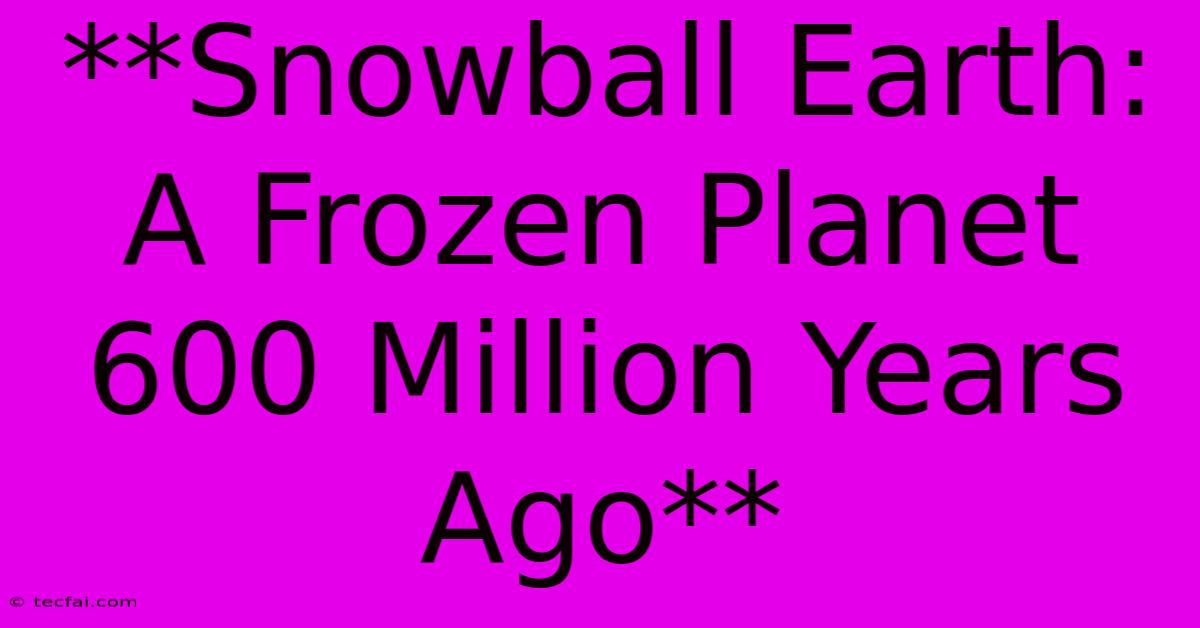**Snowball Earth: A Frozen Planet 600 Million Years Ago**

Discover more detailed and exciting information on our website. Click the link below to start your adventure: Visit Best Website tecfai.com. Don't miss out!
Table of Contents
Snowball Earth: A Frozen Planet 600 Million Years Ago
Imagine a world completely covered in ice, from the equator to the poles. This may seem like a science fiction scenario, but 600 million years ago, Earth experienced just that: a period known as Snowball Earth.
This extreme climate event, where the entire planet was encased in a thick layer of ice, lasted for millions of years and had a profound impact on life on Earth. While the exact cause of Snowball Earth remains a subject of debate, scientists have proposed several compelling theories, and its consequences continue to fascinate and intrigue researchers today.
What Caused Snowball Earth?
The leading theory suggests that a combination of factors led to this global freeze.
- Volcanic activity: Large volcanic eruptions could have released vast amounts of carbon dioxide into the atmosphere, leading to an initial warming period. However, this warming could have also led to increased weathering of rocks, which absorb carbon dioxide. This process, in turn, could have triggered a rapid cooling of the planet.
- Changes in continental drift: The position of continents, especially the formation of supercontinents, could have influenced ocean currents and wind patterns, altering global climate.
- Solar radiation: While the sun’s luminosity was weaker in the past, the Earth's orbit and the angle of its axis could have caused slight variations in the amount of solar radiation received, potentially leading to an ice age.
The Impact of Snowball Earth
The effects of Snowball Earth were dramatic and far-reaching:
- Complete ice coverage: The planet's surface was entirely covered in ice, likely extending several kilometers in depth. This ice sheet, called the Cryogenian glaciation, was a stark contrast to the warm, tropical climates that prevailed before and after this period.
- Extinction events: While life was simple and mostly microscopic at this time, Snowball Earth is believed to have led to several extinctions. The extreme conditions posed a significant challenge to life, with only the hardiest organisms surviving.
- Evolutionary boost: Ironically, Snowball Earth may have actually accelerated the evolution of life. The extreme conditions likely favored organisms with specific adaptations, such as resistance to cold and the ability to thrive in harsh environments. This led to the development of new species and a more diverse biosphere.
Evidence of Snowball Earth
While the idea of a completely frozen Earth may seem far-fetched, there is compelling evidence to support the Snowball Earth hypothesis:
- Glacial deposits: Deposits of glacial till and striated rocks found in tropical regions provide strong evidence of widespread glaciation, including regions that would have been too warm to support ice sheets under normal circumstances.
- Cap carbonates: In some areas, rock formations known as cap carbonates are found directly above glacial deposits. These rocks are rich in calcium carbonate and are believed to have formed as a result of a sudden burst of carbon dioxide released back into the atmosphere after Snowball Earth. This release likely caused a dramatic warming event, ending the glacial period.
- Geochemical evidence: Analysis of ancient rocks and minerals indicates changes in oxygen isotopes, suggesting a dramatic shift in global temperatures.
The End of the Ice Age
Although Snowball Earth was a period of extreme cold, it didn't last forever. The planet eventually thawed, leading to a rebound in life and a period of rapid evolutionary change. Scientists believe the end of Snowball Earth was likely triggered by a combination of factors, including the release of greenhouse gases from volcanic activity and the return of normal solar radiation levels.
A Legacy of Change
While Snowball Earth was a challenging and extreme period in Earth's history, it serves as a powerful reminder of the interconnectedness of climate systems and the potential for dramatic changes in our planet's environment. It also offers a valuable glimpse into the resilience of life, as organisms adapted and thrived even under the most challenging conditions.
Studying Snowball Earth helps us understand the past, present, and future of our planet and underscores the importance of maintaining a healthy and balanced climate.

Thank you for visiting our website wich cover about **Snowball Earth: A Frozen Planet 600 Million Years Ago**. We hope the information provided has been useful to you. Feel free to contact us if you have any questions or need further assistance. See you next time and dont miss to bookmark.
Featured Posts
-
Sara Sharif Case Fathers Confession In Daughters Death
Nov 14, 2024
-
Is Wednesday Season 2 Happening Updates
Nov 14, 2024
-
Kkrs Ramandeep Singh Makes India Debut
Nov 14, 2024
-
Margot Robbies Crop Top And Sandals Upgrade
Nov 14, 2024
-
Juggling Lifes Demands Practical Strategies
Nov 14, 2024
